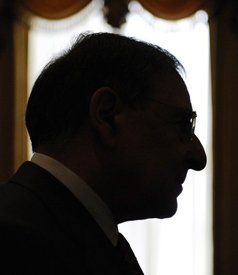
Report Reveals CIA Conducted Mock Executions
Mark Hosenball and Michael Isikoff = Newsweek
A long-awaited report on post-9/11 interrogation tactics will reveal harrowing new details about treatment of suspected terrorists.
A long-suppressed report by the Central Intelligence Agency's inspector general to be released next week reveals that CIA interrogators staged mock executions as part of the agency's post-9/11 program to detain and question terror suspects, NEWSWEEK has learned.

CIA Director Leon Panetta. (Photo: Getty Images)
According to two sources - one who has read a draft of the paper and one who was briefed on it - the report describes how one detainee, suspected USS Cole bomber Abd al-Rahim al-Nashiri, was threatened with a gun and a power drill during the course of CIA interrogation. According to the sources, who like others quoted in this article asked not to be named while discussing sensitive information, Nashiri's interrogators brandished the gun in an effort to convince him that he was going to be shot. Interrogators also turned on a power drill and held it near him. "The purpose was to scare him into giving [information] up," said one of the sources. A federal law banning the use of torture expressly forbids threatening a detainee with "imminent death."
The report also says, according to the sources, that a mock execution was staged in a room next to a detainee, during which a gunshot was fired in an effort to make the suspect believe that another prisoner had been killed. The inspector general's report alludes to more than one mock execution.
Before leaving office, Bush administration officials confirmed that Nashiri was one of three CIA detainees subjected to waterboarding. They also acknowledged that Nashiri was one of two Al Qaeda detainees whose detentions and interrogations were documented at length in CIA videotapes. But senior officials of the agency's undercover operations branch, the National Clandestine Service, ordered that the tapes be destroyed, an action that has been under investigation for more than a year by a federal prosecutor.
The new revelations are contained in a lengthy report on the CIA interrogation program completed by the agency's inspector general in May 2004, around the time that the initial, most intense phase of the CIA effort began to wind down. The purpose of the report was to examine how the CIA program had been conducted, and whether Justice Department guidelines governing the use of harsh "enhanced" interrogation techniques had been followed. According to the sources, the inspector general criticizes some agency interrogators for exceeding official guidelines in the use of extreme tactics on detainees.
Mock executions were not authorized in Justice Department memoranda that outlined the legal parameters that Bush administration lawyers believed should govern the use of "enhanced" interrogations. The Justice Department memoranda, once highly classified, were released earlier this year by the Obama administration in the face of strenuous objections from the CIA and former Bush White House officials.
The inspector general's report, commissioned by then CIA director George Tenet, was sent to the Justice Department and congressional intelligence committee leaders shortly after it was written. But it was not shown to all members of the intelligence committees until September 2006, around the time that President Bush publicly acknowledged the CIA detention-and-interrogation program and instructed the agency, which had been holding detainees in a network of secret overseas prisons, to transfer them to the U.S. military detention camp at Guantánamo Bay, Cuba.
Top Bush CIA officials, including Tenet's successors as CIA director, Porter Goss and Gen. Michael Hayden, strongly lobbied for the IG report to be kept secret from the public. They argued that its release would damage America's reputation around the world, could damage CIA morale, and would tip off terrorists regarding American interrogation tactics. "Justice has had the complete document since 2004, and their career prosecutors have reviewed it carefully for legal accountability," said CIA spokesman Paul Gimigliano. "That's already been done."
The inspector general's report is expected to fuel political debates over whether the tough interrogation methods used during the Bush administration actually worked. According to another source who has seen the document, the report says that the agency's interrogation program did produce usable intelligence.
At the same time the administration releases the inspector general's report, it is also expected to release other CIA documents that assert the agency collected valuable intelligence through the interrogation program. For months, former vice president Dick Cheney has called for these documents to be released. However, a person familiar with the contents of the documents says that they contain material that both opponents and supporters of Bush administration tactics can use to bolster their case. The Senate Committee on Intelligence is now conducting what is supposed to be a thorough investigation of the CIA's detention-and-interrogation program. The probe is intended not only to document everything that happened but also to assess whether on balance the program produced major breakthroughs or a deluge of false leads.
